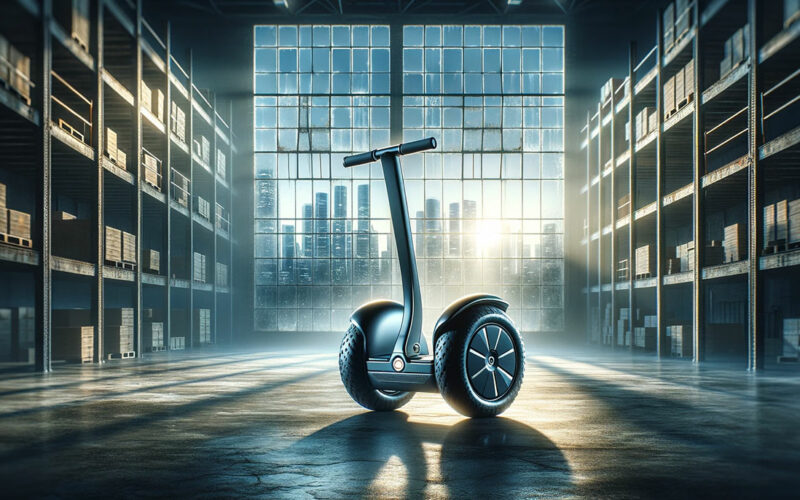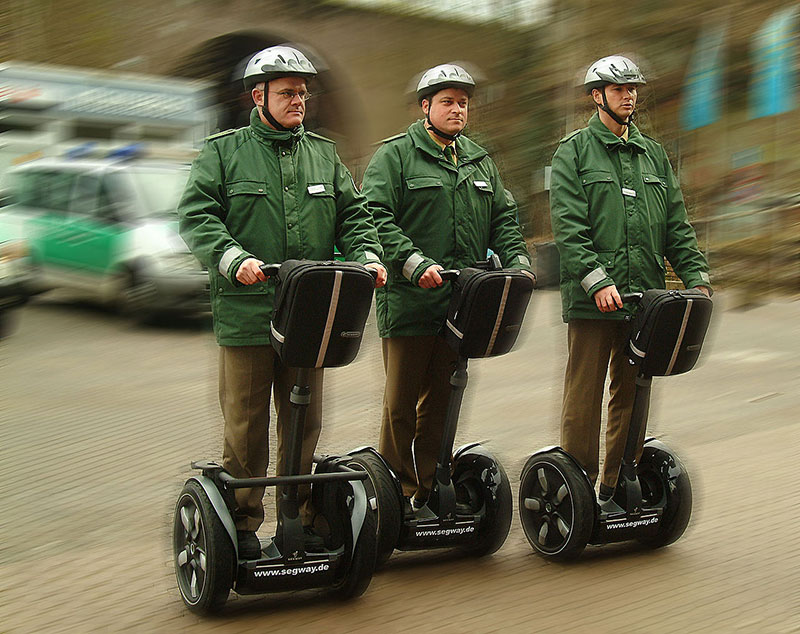Wheels Stop Rolling: What Happened to Segway?

Once upon a pavement, rolling into the future felt like a breeze with Segway, a name synonymous with innovative personal transportation. Imagine gliding through city streets, effortlessly balancing on two wheels—it was a fantasy turned reality. But even the boldest of urban chariots can stumble. You’ve probably pondered, what happened to Segway?
The story unfolds like a multi-layered road, where each turn reveals truths about ambition, technology, and market tides.
By journey’s end, here’s what you’ll unravel: the chronicle behind Segway Inc., the self-balancing act that wavered between remarkable invention and market dissonance, and the perplexing twists that led to its retreat from center stage.
From Dean Kamen’s vision to the Ninebot acquisition, through the alleys of business strategy and technological prowess, our tale delves into an odyssey of eco-ambition that subtly lost its footing.
Hop on this narrative scooter and explore the paths taken by an icon of electric mobility, leaving no stone unturned, no patent unexplored, no gyroscopic mystery unsolved.
Herein, every anecdote serves as a waypoint to understanding the larger mobility industry landscape as we probe the curious case of a vehicle designed to stand the test of time, yet somehow didn’t.
The Hype and Launch
Pre-Launch Hype
Ever seen something shrouded in so much secrecy it just had to be big? That was the Segway, pre-launch.
Insiders whispered, and big names threw their weight behind it, stirring up a public frenzy. It was all cloak and dagger until the big reveal. The buildup was immense, akin to the anticipation before the unveiling of the latest, greatest gadget today.
Secrecy and Insider Endorsements
Every whisper about Segway’s personal transporter was like a breadcrumb leading to a banquet of innovation.
Those in the know promised a revolution on two wheels. Even Steve Jobs said it was “as big a deal as the PC.”
Public Expectations vs. Reality
The public was on the edge of their seats, expecting to witness the dawn of a new era in personal transport. The reality? Well, it was a bit of a mixed bag.
The Segway did wow folks with its self-balancing mechanism and its smooth glide over sidewalks. But, let’s just say, it wasn’t the overnight sensation everyone was betting on.
Unveiling of Segway
Then came the grand entrance. It was supposed to be a parade but felt more like a whisper in the tech community.
Initial Public Reception
When Segway finally stepped into the limelight, reactions were… varied. Some were enchanted by this two-wheeled wonder that responded to the rider’s lean. Early adopters were all in, ready to herald in the new wave of getting around.
Discrepancy between Vision and Public Perception
But then, there was the other side of the coin. For every enthusiast, there was a skeptic. The discrepancy was clear.
People had dreamed of jetpacks and flying cars; what they got was something that, while nifty, wasn’t shattering any molds.
The public perception was a mixed bag; some thought it was cool, others couldn’t help but ask, “What happened to Segway’s promise of a revolution?”
Design and Functionality
Technological Innovation
So, let’s talk about the wheels and wires of this whole Segway saga. Picture this: a scooter-looking gizmo that magically keeps you upright without so much as a wobble.
The self-balancing mechanism was nothing short of wizardry, tapping into gyros and computers before most of us even had Wi-Fi.
Self-balancing mechanism
The balance on this thing? Like a tightrope walker. You lean forward, and whoosh, you’re moving. Lean back, and you come to a smooth halt.
No handles, just your body chatting with the machine like they’re old pals.
Advanced features and capabilities
Beyond just staying upright, the Segway had tricks up its sleeve. We’re talking zippy speeds that outpace a brisk walk and the eco-friendly buzz of electric motors.
It whispered through streets without a puff of exhaust—a nod to greener urban transport dreams.
Design Limitations
But, hold up. Not everything was sunshine and electric rainbows.
Urban infrastructure challenges

Cities weren’t ready for a flood of Segways on sidewalks. Urban infrastructure was a maze of “Nope, can’t ride that here.”
There was no roadmap for this kind of ride, and it left a lot of early adopters scratching their heads, trying to figure out where they could actually cruise without causing a stir.
Safety concerns and high-profile accidents
Then there’s the safety jazz. Sure, Segways were cool until they weren’t—like when a few high-profile wipeouts hit the headlines.
People began to side-eye their once-beloved scooters, wondering if they were more danger-on-wheels than wheels-of-the-future.
Marketing and Sales
Marketing Strategy
Alright, onto getting the word out and the Segways rolling off the lot.
Broad targeting vs. niche focus
The marketing masterminds had their sights set on everyone. “Why walk when you can glide?” was the mantra.
But was it for the business folks? The tourists? Security teams? The net was cast wide, but maybe too wide, you know?
Engagement with commercial entities
Then came the handshake deals with the suits. Segway courted police departments, tour groups, and anyone else who needed to zip around large spaces.
It made sense—less about being a gadget, more about being the go-to mobility tool.
Sales Performance
Now, let’s talk shop—the numbers, the real score.
Initial profitability and adoption
Early days were like a hit song in summer. They sold the idea of a personal transport revolution, and the early adopters were singing along, wallets out and ready.
Decline in demand and discontinuation
But fast forward a bit, and the tune changed. Sales started to slump. People began to whisper, “what happened to Segway?” and not because they wanted to buy one.
It went from the next big thing to a question mark in the tech history books.
Challenges and Setbacks

Regulatory and Safety Issues
When I dive into the whole “what happened to Segway” question, it’s like opening a can of worms, but let’s get into it.
Regulatory interventions
Turns out, lawmakers weren’t exactly throwing a welcome party for Segway.
Cities were all, “Hold up, where do we put these things?” Streets or sidewalks, neither felt quite right.
It’s like showing up to a fancy dress party in your PJs—Segway didn’t quite fit the scene.
And with each city drawing its own lines in the sand, it got pretty messy for users to figure out where they could roll without getting the side-eye from the authorities.
Safety gear awareness and accidents
Plus, nobody was really talking about safety gear. Helmets? Knee pads? It wasn’t cool, until, well, you know, it suddenly was—after a few tumbles.
And when a couple of high-profile spills made the rounds on the news, the whispers started. “You see what happened to Segway?” Suddenly, the cool factor started to tank.
Competition and Alternatives
Emergence of e-scooters and other modes of transport
Then, as if on cue, in roll the e-scooters, bikes, and everything else on wheels.
E-scooters were like the younger siblings that came to the party late but somehow stole the show. They were hip, handy, and—let’s face it—cheaper.
Segway was like the pricey entree at a buffet when everyone just wanted the fries.
Comparison with low-tech alternatives
Even the good old-fashioned bike started to look real good again. No tech fuss, just pedal and go. Sometimes low-tech is the tech we want, you know?
The Fall of Segway
Niche Market Position
Lack of a clearly defined target audience
This is where the plot thickens, and the “what happened to Segway” story gets its climax.
Segway tried to be the Jack of all trades but ended up the master of none. Was it for the commuters, the cops, the tourists? It blurred lines, and not in the cool, catchy-song kind of way.
Segway’s role in niche markets (mall cops, tourism)
Sure, it found its corners. Mall cops and city tours loved these things. They were like part of the uniform for some.
But a couple of niche spots couldn’t prop up the whole show. It’s like being famous in your hometown but nowhere else.
Discontinuation
Ninebot’s decision to stop production
And then came the news, like a quiet post on a bulletin board that changes everything.
Ninebot, the big dog who took over the Segway gig, called it. “We’re done,” they said. “The Segway PT is rolling off into the sunset.” And just like that, it was the end of an era.
Durability issues and impact on sales
They talked about durability issues, which is business speak for “these things were built too tough.”
They lasted ages, so folks weren’t buying new ones. It’s like owning a tank when you were supposed to be selling sports cars. Great for the user, not so great for the sales charts.
Reflections and Legacy
Cultural Impact
So, let’s talk about the ripple effects, right? The whole “what happened to Segway” convo gets even juicier when we peek at the cultural waves it made.
Segway as a cultural meme
First off, Segways became this kind of meme before memes were even a big deal. They popped up as this icon for, like, techy goofiness.
Picture this: someone cruising on a Segway, sipping a latte, and boom, you’ve got a whole vibe. A vibe that says, “I’m living in the future, but I can’t run from my past of rollerblades and razor scooters.”
Representation in media and popular culture
And Hollywood? Man, they had a field day. Segways showed up in flicks and shows, rolling under some of the funniest cats on screen.
They were like this shorthand for a certain kind of person or moment—usually someone a bit out of touch, trying way too hard to be on the cutting edge.
Lessons Learned
Now, let’s break down the real talk, the lessons we’ve picked up from the Segway saga.
The gap between innovation and practicality
Innovation’s a tricky beast. You can create the slickest, shiniest new toy on the block, but if it doesn’t click with the day-to-day grind, well, you’re kinda stuck.
Segway was a masterpiece of tech, sure, but the streets weren’t ready—literally. It’s like showing up to a knife fight with a laser gun. Cool, but can you actually use it without causing a scene?
Marketing lessons from the Segway’s journey
And then there’s the marketing magic—or in this case, the missing magic.
Segway’s hype machine was working overtime, but when the rubber hit the road, the follow-through felt flat. It’s like promising a blockbuster movie and then delivering a straight-to-DVD sequel.
Segway taught us that your market needs to be more than just an idea; it needs to be as real as the ground beneath those two wheels.
FAQ On What Happened To Segway
Why did Segway stop production?
Segway Inc. hit the brakes on their iconic PT model due to a combo of factors. Sales didn’t exactly zoom past expectations; we’re talking niche markets mostly—tourist rentals and security patrols. Plus, the urban landscape got crowded with other electric scooters and rideables. It was adapt or get off the sidewalk.
What went wrong with the Segway PT?
The Segway PT was genius but stumbled over its two-wheeled ingenuity. Let’s face it, it never really dodged its rep for being pricey and a bit bulky. Parking it in mainstream culture proved tough. It also had to skate around strict regulations and consumers just unsure where this fit in daily grind.
Who bought Segway company?
The plot twist came when Ninebot, a Chinese mobility outfit, swooped in. These folks already had their fingerprints on the electric rideable scene. So, in 2015, they penned a deal, blending Segway‘s tech with their own flavor of innovation. It was a merge signaling new horizons for our balancing act.
When did Segway go out of business?
Out of business? Not quite. More like a transformation. Segway Inc. didn’t disappear, it was more of a strategic pivot. The PT model bowed out in July 2020, but the company powered forward, focusing on newer electron-powered movers and shakers like scooters and the like.
How many Segways were sold?
We’re counting over 140,000 of those self-balancing scooters since Dean Kamen unveiled them. Sure, it doesn’t spark fireworks compared to smartphones and such. But hey, for a futuristic gizmo that got us to rethink hoofing it, not too shabby.
Did Segway ever make a profit?
Straight talk? It wasn’t a home run for the profit columns. Despite the buzz, Segway didn’t quite catch the cash wave as hoped. The PT, while cool as cucumber, didn’t transform wallets into open floodgates. It’s a tough gig to greenlight those margins when your ride caters to a particularly quirky bracket.
Is the Segway company still around?
Absolutely. They didn’t roll into the sunset. Segway morphed, thanks to Ninebot playing fairy godparent. These days, they’re dishing out transportation toys like e-scooters and have their sights on future tech. Segway’s spirit keeps buzzing, just in a different shell.
Are Segway tours still a thing?
For sure. The Segway name still spins its magic for tourists. Cities worldwide still offer those quirky two-wheeled excursions. Call it a slice of nostalgia or simply fun, but there’s still juice left in those old tours for fetching some grins.
What is replacing Segway?
Electric scooters, hoverboards, skateboards—the streets are now a buffet of alternatives. Tech’s always on the prowl, cooking up the next ride that whispers future. Segway’s tech lives on, though, even if it’s not the star of the show anymore.
What is Dean Kamen working on now?
A mind like Dean Kamen’s never idles. He’s brewing up science magic at DEKA Research & Development, responsible for goodies like a bionic arm. The guy’s passion for change hasn’t skipped a beat. He’s all about tech for the greater good, from medicine to clean water projects.
Conclusion
So, cruising to the end of our ride, what happened to Segway isn’t just a tale of tech meeting roadblock—far from it. It’s about evolution, a company that zigzagged through innovation, faced market flip-flops, and still rolled on.
See, Segway’s spirit endures, not as a memento but as a blueprint parlayed into scooters and bots dotting our sidewalks.
You’ve strapped in and journeyed through the two-wheeled wonders of Segway, from Dean Kamen’s brainstorm to the gears clicking into place with Ninebot.
And hey, the tours, the gizmos, the sight of those gyroscopic dancers—they’re still threading through our urban fabric.
In every byte and bolt, Segway whispered a future we could almost touch. Although the Segway PT has taken its final bow, the tracks it left on the gadget landscape—they’re indelible.
Now it’s about watching this legacy, in all its forms, cruise into the next chapter.
If you liked this article about what happened to Segway, you should check out this article about what happened to Yik Yak.
There are also similar articles discussing what happened to Zulily, what happened to Anki, Freshly shutting down, and what happened to Turntable.fm.
And let’s not forget about articles on what happened to Juicero, what happened to ChaCha, why Blockbuster failed, and Argo AI shutting down.
- Drive and Earn: Essential Apps Like Doordash - May 8, 2024
- The Benefits of Integrating Geofencing with CRM Systems - May 8, 2024
- Create Your Game: The Best JavaScript Game Engines - May 8, 2024








